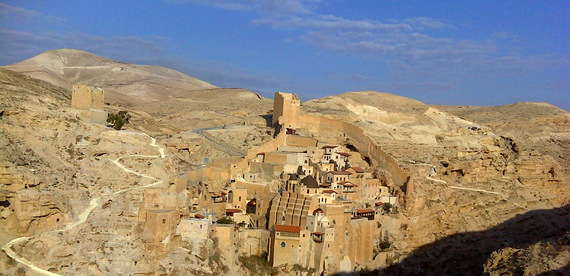Here I am; not walking but waiting. It is a sunny winter afternoon and I sit under the imposing tower of one of the most spectacular monasteries in the Middle East. This is the Lavra of Mar Saba, one of those bastions of Christian culture, sitting tough in a region where religious minorities do not do well, to put it mildly. But Palestine is not Iraq (and Jordan is not Syria, and South Sinai is not North Sinai, and one could ramble on for quite a bit between perception and reality) and the desert here is its own world.
My back against the wall, I have been waiting for an hour for a sign of life from within; for somebody to open the mysterious little door, a main entrance that looks like a secretive back gate. I knock a couple of times. No reply. Pulling an ingenious small iron lever sets off a myriad of bells inside. Surely, they can hear this all the way to Bethlehem? More silence follows. Monastic life requires patience. I sit down again. Another twenty minutes and I hear footsteps, the shifting of heavy wood and iron and the little door finally opens. After looking in from the outside on so many previous visits, I finally enter Mar Saba, one of the most wondrous desert monasteries in the world.
Mar Saba is on the Abraham Path and a myriad of other trails that cross the desert between the Dead Sea and the populated hills of the West Bank. For years I made repeat visits to this place on foot but I was never able to enter through this small front gate. I walked here from the ruins of Hyrcania where King Herod killed some of his enemies, and from the peak of Jebel Muntar which commands views over the Jordan Valley amidst Byzantine ruins. Once, we started near the Islamic shrine of Nabi Musa in the valley itself and climbed up towards Mar Saba. It was June and we were simmering in a frying pan. I learnt every walk here has a firm expiry date and we surpassed it that day. In the oppressive heat, the sight of Mar Saba hanging from the cliffs reminded me of Mark Twain's description in Innocents Abroad as he approached it in 1867:
The sun so pelted us that the tears ran down our cheeks once or twice. The ghastly, treeless, grassless, breathless canons smothered us as if we had been in an oven. The sun had positive weight to it, I think. Not a man could sit erect under it. All drooped low in the saddles. John preached in this "Wilderness!" It must have been exhausting work.
In contrast to Twain's visit, none of my walks were rewarded with an actual entry. Monks are not caterers in the merry-go round of holy land tourism. They prefer No over Yes, especially to women whose entry has been banned by the desert fathers for over 1500 years. There is no arguing with tradition. According to local legend, a woman once tried to enter Mar Saba dressed up as a man; however, the earth started shaking and so the priests quickly found out on this imposter.
So there I am on a winter afternoon, finally able to not only see Mar Saba from within but also spend one night inside the Monastery thanks to the blessings of the Greek-Orthodox Archbishop in Jerusalem, an arrangement that took months to pull off. It appears the message has come through. A Greek monk by the name of Vasilias guides me around and shows me my cell for the night, a small sober room with a wooden table and chair, an oil lamp, a box of matches and two small beds with woolen blankets to fend off the cold at night. A little window gives me a partial view over Wadi Nar -- the wadi of fire...- below.
Vasilias gives me a small iron key to lock my cell. I wonder who could possibly want to climb the outer walls in the middle of the desert to nick my watch. But then I remember the djins, the evil spirits that always attempt to cause havoc in and around the Monastery; and Bedouin robbery; and raids of Persian barbarians. Perhaps long ago for many but inside a Monastery time meddles with you. I put the key safely away in my pocket.
Vasilias continues with a tour of Mar Saba's epicenter, its two churches, the tomb of St Sabas and the puzzling maze-like ramparts connected by connected by small stairs, little doors and hidden overpasses. In Saba's time and in the centuries after him, the desert converted into its own kind of city. From Egypt to Palestine, monks left their urban centers of worship and learning and settled in the barren lands of the desert to nourish the soul and distance themselves from the material world. They found God in the desert. As many as 150 monasteries are estimated to have flourished across the deserts of the Holy Land in the two centuries after St Sabas. Entire monastic cities arose. But it was no congregation, no social camping in the wild: the monks did not live inside the protective walls but led a hermit life in the cluster of cells and caves spread over the gorges and hills. Subsisting on little else than bread and water during the week, they gathered at the church for communal prayer on Saturdays and Sundays.
From Vasilias, I hear of the many miracles of St Sabas and his Lavra. Of mysterious wells under the monastery and incorruptible corpses buried inside it. Divine protection was not always sufficient. In the chapel some 140 monk skulls are displayed in glass cabinets: martyred by Persian armies in the 7th century. Vasilias recounts the events to me as if they happened yesterday.
Time is of a different dimension altogether here. As the Lavra turns into darker colors of yellow and gold and the sun starts setting in the west I learn that time-keeping is still a Byzantine affair. The clock in my room points to a little past twelve o'clock when my watch says it's about five-ish in the afternoon. One of the monks patiently explains to me that this is the actual time in the monastery: the moment the sun sets, the day is considered past and a new day starts. They gather for their last prayers and then retire to their rooms to rest. Mar Saba's courtyard turns into dark blue; a cloud covered sky gently passes. Birds soar over. A strange weariness falls over me. It is six p.m. I'm in Byzantium, weary and retire to my cell.
At around eight o'clock (just after one a.m. on my watch), the first church service commences. The moon has put on a yellow glow on Mar Saba's inner courtyard. I am told that because I am not Greek Orthodox I will only be allowed to attend the first part of the ceremony. It reminds me of Twain who also spent a night here in 1867. As with all his remarks on the people of the Holy Land he pulls no punches on the desert fathers:
They wear a coarse robe, an ugly, brimless stove-pipe of a hat and go without shoes. They eat nothing whatever but bread and salt; they drink nothing but water. As long as they live they can never go outside the walls, or look upon a woman -- for no woman is permitted to enter Mars Saba, upon any pretext whatsoever. Some of those men have been shut up there for thirty years. In all that dreary time they have not heard the laughter of a child or the blessed voice of a woman; they have seen no human tears, no human smiles; they have known no human joys, no wholesome human sorrows. In their hearts are no memories of the past, in their brains no dreams of the future.
But then at least he was gracious enough to express his gratitude for their hospitality:
When we got up to breakfast in the morning, we were new men. For all this hospitality no strict charge was made. We could give something if we chose; we need give nothing, if we were poor or if we were stingy. The pauper and the miser are as free as any in the Catholic Convents of Palestine.
A striking detail of Twain's travel journal was his description of these Greek-Orthodox monks as "Catholics." It reflects the worldview of the American pilgrim group of which Twain was a member with Christianity divided into two simple strands; Protestantism and the rest. After the service, I go back to bed to catch up on some sleep. A few hours later I am awoken to a cell-delivered breakfast consisting of tea sweetened with milk and honey, and a humble jumble of small sweet snacks and pastries. This is not the monastic diet of old dry bread and salty cheese that I read about. Have I woken up on a particular feast day celebrating the life of one of the many saints that are revered here? Or, as a non-Greek Orthodox guest, am I treated with some kind of special courtesy?
In the early morning light, one more time I walk around the quiet inner maze of Mar Saba's halls, overpasses and endless stairs and gates. I then leave its gates and descend around the backside, crossing over the waters of Wadi Nar to climb the steep cliffs opposite and see the first sun light touch the dark grey domes of the St Nicholas church. They stand mightily in the morning sky. From here, a small footpath takes you towards the Dead Sea across dry and barren land, alive with millennia of history.

